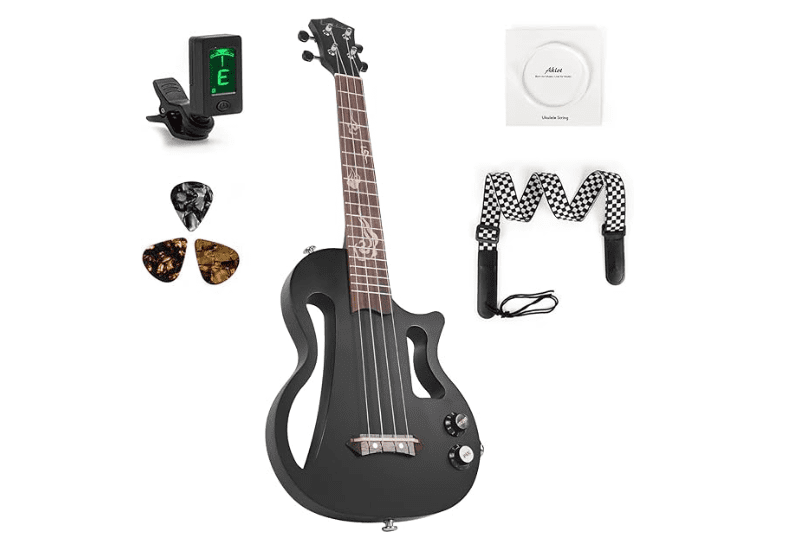Must-Have Accessories for Electric Ukuleles

Introduction
Electric ukuleles are gaining popularity among musicians of all genres due to their unique ability to blend traditional ukulele sounds with modern amplification. This article aims to educate you about the essential accessories that can enhance your electric ukulele experience. Whether you are new to the electric ukulele or a seasoned player, the right accessories can significantly improve your sound and performance.
Understanding Electric Ukuleles
What Makes an Electric Ukulele Different?
Electric ukuleles differ from acoustic ones in several ways, primarily in construction and sound production. Unlike acoustic ukuleles, which rely on their hollow bodies to project sound, electric ukuleles use pickup systems to convert string vibrations into electrical signals. These signals can then be amplified and modified, allowing for a much broader range of sound possibilities.
- Construction: Electric ukuleles typically have solid or semi-hollow bodies. This design helps to reduce feedback when the instrument is amplified. The materials used in electric ukuleles are often similar to those in electric guitars, including woods like mahogany, maple, and rosewood.
- Sound Production: The pickup system is the heart of an electric ukulele’s sound production. There are two main types of pickups: piezo and magnetic. Piezo pickups are placed under the saddle and capture the vibration of the strings. Magnetic pickups, similar to those used in electric guitars, capture the magnetic field generated by the strings. Some electric ukuleles even combine both types of pickups for greater versatility.
Electric ukuleles also feature controls such as volume and tone knobs, allowing players to adjust their sound directly from the instrument. These features make electric ukuleles incredibly versatile, suitable for various musical styles and performance settings.
Benefits of Electric Ukuleles
Electric ukuleles offer several advantages over their acoustic counterparts:
- Amplified Sound: One of the primary benefits is the ability to amplify your sound. This is particularly useful for live performances and recordings, where you need your ukulele to be heard clearly over other instruments. Amplification allows for greater volume and clarity, making your performance more impactful.
- Versatility: Electric ukuleles can be connected to effects pedals and amplifiers, offering a wide range of tonal possibilities. You can easily switch between different genres, from rock and pop to jazz and blues, by adjusting your setup. The ability to use various effects, such as reverb, delay, and distortion, adds another layer of creativity to your playing.
- Playability: Many electric ukuleles are designed with playability in mind. They often have slimmer necks and lower action, making them easier to play, especially for beginners. The reduced feedback and greater control over your sound make electric ukuleles a joy to play in any setting.
These benefits make electric ukuleles an excellent choice for musicians looking to expand their sonic palette and experiment with new sounds.
Essential Electric Ukulele Accessories
Overview of Essential Accessories
To fully realize the potential of your electric ukulele, you’ll need a variety of accessories. These items enhance playability, protect your instrument, and ensure it remains in top condition. Here are the must-have accessories for electric ukuleles:
- Amplifiers
- Effects Pedals
- Cases and Gig Bags
- Straps and Stands
- Maintenance and Care Products
- Tuners and Metronomes
- Pickup Upgrades
Each of these accessories plays a crucial role in enhancing your electric ukulele experience. Let’s delve into the details of each category.
Amplifiers
Amplifiers are essential for any electric ukulele player. They not only increase the volume but also allow for tone shaping and effects integration, significantly enhancing your sound.
Types of Amplifiers
There are several types of amplifiers to consider:
- Acoustic Amps: These amps are designed to reproduce the natural sound of your ukulele with clarity and fidelity. They are perfect for those who want to maintain the acoustic quality of their instrument while amplifying it.
- Electric-Specific Amps: These amps offer more features for sound modification, including built-in effects and equalizers. They are ideal for players who want to experiment with different sounds and tones.
- Portable Amps: These are lightweight and compact, making them great for traveling musicians. Many portable amps run on batteries, making them convenient for outdoor performances or busking.
Factors to Consider
When choosing an amplifier, consider the following factors:
- Wattage: The wattage of an amp determines its volume and power. Practice amps typically range from 10-30 watts, while performance amps are 50-100 watts or more. Choose the wattage based on your playing environment.
- Portability: If you travel frequently, look for lightweight and compact models. Portable amps are easy to carry and set up, making them ideal for gigging musicians.
- Built-In Features: Consider amps with built-in EQ controls, effects loops, and connectivity options like USB and Bluetooth. These features add versatility and convenience to your setup.

Popular Models
Here are some popular amplifier models for electric ukuleles:
- Fender Acoustasonic 15: Known for its portability and clean sound. It’s perfect for small gigs and practice sessions.
- Roland Cube Street: Offers built-in effects and battery operation, making it ideal for busking and outdoor performances.
- Boss Katana Mini: Renowned for its powerful sound and compact size. It’s a versatile option for both practice and performance.
Tips for Optimizing Amplifier Settings
To get the best sound from your amplifier, follow these tips:
- Tone Settings: Adjust the bass, mid, and treble controls to suit your playing environment. Experiment with different settings to find the sound that works best for you.
- Volume Control: Ensure the amplifier volume matches the venue size without causing feedback. Start with a low volume and gradually increase it until you reach the desired level.
Maintenance Tips
Regular maintenance can extend the life of your amplifier:
- Cleaning: Regularly clean amplifier vents to prevent dust buildup. Use a soft cloth to wipe down the exterior.
- Check Connections: Ensure all cables and connections are secure to avoid electrical issues. Inspect the power cord and input jacks for any signs of wear.
Effects Pedals
Effects pedals can dramatically alter your ukulele’s sound, adding depth and character to your music. They offer endless possibilities for creativity and experimentation.
Types of Effects Pedals
There are several types of effects pedals to consider:
- Reverb: Adds space and dimension to your sound, simulating the acoustics of different environments.
- Delay: Creates echo effects, adding depth and texture to your playing.
- Chorus: Modulates your tone to make it sound richer and more vibrant.
- Distortion: Adds grit and edge, perfect for rock and blues styles.
- Loopers: Allow you to record and layer multiple tracks in real-time, creating complex compositions.
Using Effects Pedals
Combining different effects can create unique and interesting sounds. For example, using delay with reverb can produce a spacious, ambient tone. Building a pedalboard involves arranging pedals in a signal chain, considering power requirements, and ensuring optimal placement for each pedal.
- Signal Chain: The order in which you connect your pedals affects the overall sound. Typically, modulation effects like chorus and delay are placed after distortion and overdrive pedals.
- Power Requirements: Ensure your power supply can handle the total power consumption of your pedals. Consider using a power brick with isolated outputs to prevent noise and interference.
- Pedal Placement: Experiment with different pedal placements to find the configuration that works best for you. Some players prefer to place their most-used pedals closer to the front for easy access.
Maintenance Tips
Proper maintenance can keep your pedals in top condition:
- Clean Contacts: Prevent signal loss by keeping pedal contacts clean. Use a contact cleaner and a soft cloth to clean the jacks and switches.
- Store Properly: Keep pedals in a dry place to avoid corrosion. Use a pedalboard case to protect them during transport.
Learning Resources
To learn more about using effects pedals, check out online tutorials and musician forums. Websites like Premier Guitar and Reverb offer valuable insights and tips from experienced musicians.
Cases and Gig Bags
Proper protection for your ukulele is essential, especially if you travel frequently. A good case or gig bag can safeguard your instrument from damage and environmental factors.
Types of Cases
There are several types of cases to choose from:
- Hardshell Cases: Offer maximum protection with a rigid exterior. They are ideal for air travel and long-term storage.
- Soft Cases: Lightweight and easy to carry, but provide less protection. They are suitable for short trips and casual use.
- Gig Bags: Combine the features of both hardshell and soft cases, offering padded protection and portability.
Features to Consider
When choosing a case or gig bag, consider the following features:
- Padding: Ensure the case has adequate padding to protect against impacts. Look for cases with thick, high-density foam padding.
- Waterproofing: Important for protecting your instrument from moisture. Some cases come with built-in waterproofing or rain covers.
- Ergonomic Design: Look for comfortable handles and straps for easy carrying. Adjustable shoulder straps and padded handles can make a big difference.

Traveling Tips
For musicians who travel frequently, here are some tips:
- Airline Regulations: Check if the case meets airline size requirements. Some airlines allow you to carry your instrument as hand luggage, but it’s best to confirm in advance.
- TSA Locks: Consider cases with TSA-approved locks for secure travel. These locks can be opened by airport security without damaging your case.
Maintenance Tips
Regular maintenance can extend the life of your case or gig bag:
- Clean Interiors: Regularly clean the inside of the case to prevent dust buildup. Use a vacuum cleaner with a brush attachment to remove dirt and debris.
- Inspect Zippers: Ensure zippers and seams are intact to avoid accidental openings. Lubricate zippers with a silicone-based lubricant to keep them running smoothly.
Straps and Stands
Using straps and stands can improve your playing comfort and protect your ukulele.
Benefits of Straps
Straps offer several ergonomic benefits:
- Reduced Strain: Using a strap can reduce strain on your neck and shoulders during long playing sessions. This is especially important for heavier electric ukuleles.
- Adjustability: Look for straps that can be adjusted to fit your playing style. Adjustable straps allow you to find the most comfortable playing position.
- Security: Ensure the strap has locking mechanisms to prevent accidental drops. Strap locks can provide additional security, especially during live performances.
Types of Stands
There are different types of stands to consider:
- Floor Stands: Provide easy access and display of your ukulele. They are ideal for home use and studio settings.
- Wall Mounts: Save space and keep your instrument safe from accidental knocks. Wall mounts are great for small spaces and can also serve as a decorative display.
Choosing the Right Stand
When selecting a stand, consider the following factors:
- Stability: Ensure the stand is stable on different surfaces. Look for stands with non-slip rubber feet for added stability.
- Portability: Consider foldable stands if you travel often. Portable stands are lightweight and easy to carry, making them ideal for gigging musicians.
Maintenance Tips
To keep your straps and stands in good condition, follow these tips:
- Clean Straps: Regularly clean straps to maintain their appearance and function. Use a mild soap and water solution to clean fabric straps. For leather straps, use a leather cleaner and conditioner.
- Inspect Stands: Check stands for stability and wear to prevent accidents. Tighten any loose screws and replace worn-out rubber feet.
Maintenance and Care Products
Keeping your electric ukulele in top condition requires regular maintenance and care. Proper maintenance ensures your instrument remains playable and sounds its best.
Cleaning Products
To clean your ukulele, you’ll need the following products:
- Cloths: Use microfiber cloths to clean the body and strings. Microfiber cloths are gentle on the finish and do not leave lint behind.
- Polishes: Choose polishes suitable for your ukulele’s finish. Avoid using furniture polish or household cleaners, as they can damage the finish.
- Cleaners: Avoid harsh chemicals that can damage the finish. Use cleaners specifically designed for musical instruments.
Routine Maintenance
Regular maintenance includes:
- String Changing: Regularly change strings to maintain sound quality. Old strings can lose their tone and become difficult to tune.
- Humidity Control: Use humidifiers to prevent wood from drying out. Maintaining the proper humidity level is crucial for the longevity of your ukulele.
- Seasonal Adjustments: Adjust the truss rod to accommodate changes in temperature and humidity. Seasonal changes can affect the neck of your ukulele, causing it to warp or bow.
Tools for Maintenance
To perform maintenance tasks, you’ll need the following tools:
- Fretboard Conditioners: Keep the fretboard smooth and playable. Apply a small amount of conditioner to a cloth and rub it into the fretboard.
- Neck Adjustment Tools: Maintain optimal playability by adjusting the neck. Use a truss rod wrench to make adjustments as needed.

Inspection Checklist
Regularly inspect your ukulele for potential issues:
- Loose Hardware: Tighten any loose screws or hardware. Loose hardware can affect the playability and sound of your ukulele.
- Fret Wear: Check for worn frets and consider leveling if necessary. Worn frets can cause buzzing and intonation problems.
- Electronics: Ensure pickups and wiring are in good condition. Check for any loose connections or damaged wires.
Accessories for Performance Enhancement
Tuners and Metronomes
Accurate tuning and rhythm are essential for any musician. Tuners and metronomes help you achieve and maintain these aspects of your playing.
Types of Tuners
There are several types of tuners available:
- Clip-On Tuners: Convenient and easy to use. Clip-on tuners attach to the headstock of your ukulele and detect vibrations directly from the instrument.
- Pedal Tuners: Integrate seamlessly with effects pedalboards. Pedal tuners are great for live performances, as they allow for quick and accurate tuning.
- Tuning Apps: Offer a range of features for precise tuning. Many tuning apps are available for smartphones and tablets, providing a portable tuning solution.
Benefits of Metronomes
Metronomes help develop consistent timing and rhythm skills:
- Timing and Rhythm: Metronomes provide a steady beat to practice with, helping you develop a sense of timing and rhythm.
- Adjustable Settings: Set the tempo and time signature to suit your practice needs. Some metronomes also offer features like accent beats and subdivisions.
Using Tuners and Metronomes
Integrate tuners and metronomes into your practice routine to improve pitch stability and timing. Start with slow tempos and gradually increase the speed as you become more comfortable.
Maintenance Tips
To keep your tuners and metronomes in good working condition, follow these tips:
- Calibrate Tuners: Ensure tuners are accurate by calibrating regularly. Follow the manufacturer’s instructions for calibration.
- Replace Batteries: Keep spare batteries for uninterrupted use. Check the battery level regularly and replace as needed.
Pickup Upgrades
Upgrading your pickups can significantly enhance your electric ukulele’s sound. New pickups can provide better clarity, dynamic range, and tonal options.
Types of Pickups
There are several types of pickups to consider:
- Piezo Pickups: Capture the natural sound of the strings. Piezo pickups are typically installed under the saddle and are known for their bright, clear tone.
- Magnetic Pickups: Offer a warmer, electric tone. Magnetic pickups are similar to those used in electric guitars and provide a more traditional electric sound.
- Dual-Source Systems: Combine both piezo and magnetic pickups for a versatile sound. These systems allow you to blend the two types of pickups, providing a wide range of tonal possibilities.
Benefits of Upgrading
Upgrading your pickups offers several benefits:
- Enhanced Clarity: Improve the clarity and responsiveness of your sound. New pickups can provide a cleaner, more defined tone.
- Dynamic Range: Increase the dynamic range for a fuller sound. Better pickups can handle a wider range of volumes and playing styles.
Installation Considerations
When installing new pickups, consider the following:
- Compatibility: Ensure the pickup is compatible with your ukulele model. Some pickups may require specific installation procedures or modifications.
- Professional Installation: Consider having a luthier install the pickups for optimal performance. Professional installation ensures the pickups are installed correctly and securely.
Maintenance Tips
Regular maintenance can keep your pickups in top condition:
- Clean Pickups: Regularly clean pickups to maintain sound quality. Use a soft cloth to remove dust and debris.
- Adjust Settings: Fine-tune height and sensitivity for the best performance. Adjust the pickup height to balance the volume between strings.
Conclusion
Enhancing your electric ukulele experience involves investing in the right accessories. From amplifiers and effects pedals to cases and maintenance tools, each accessory plays a crucial role in improving playability, protection, and sound quality.
The versatility and creativity enabled by these accessories are boundless. Experiment with different setups to find what works best for you and personalize your electric ukulele experience.

